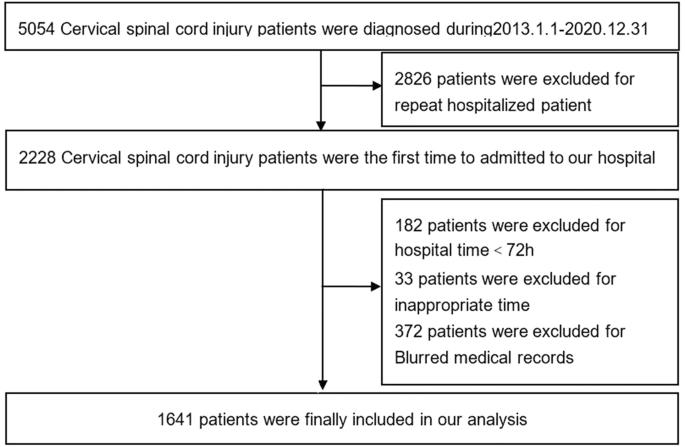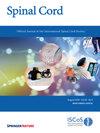颈椎脊髓损伤患者气管切开和拔管的长期趋势和风险因素。
IF 2.1
4区 医学
Q3 CLINICAL NEUROLOGY
引用次数: 0
摘要
研究设计回顾性研究:调查中国康复研究中心(CRRC)北京博爱医院在过去8年中颈脊髓损伤(CSCI)后气管切开和拔管的风险因素及其流行病学变化:地点:中国康复研究中心北京博爱医院:我们回顾了中国康复研究中心 8 年(2013.1.1 至 2020.12.31)的患者数据,重点关注住院并确诊为 CSCI 的患者。我们分析了人口统计学和临床数据的变化趋势。采用逻辑回归分析确定影响气管切开和拔管的因素:最终,1641 名 CSCI 患者符合纳入标准。在过去的 8 年中,气管插管的 CSCI 患者比例为 16.3%,气管插管的 TCSCI 患者中成功拔管的比例为 77.9%。我们发现,创伤性(OR = 1.8,95% CI = 1.06,3.22;P = 0.046)、运动水平损伤(C5-C8)(OR = 0.32,95% CI =-1.91,-0.34;P = 0.005)、AIS = A/B/C (OR = 22.7/11.1/4.2, 95% CI = 12.16,42.26/5.74,21.56/2.23,7.89; p 56 (OR = 1.6, 95% CI = 1.04, 2.32; p = 0.031)是气管切开的危险因素。通过多变量逻辑回归分析TCSCI气管插管患者拔管失败的风险因素,发现年龄大于45岁(OR = 4.1,95% CI = 1.44,11.81;P = 0.008)、完全损伤(OR = 2.7,95% CI = 1.26,5.95;P = 0.011)、面神经脱位(OR = 2.8,95% CI = 1.13,7.07;P = 0.027)等因素存在显著统计学差异:近年来,CSCI 的流行病学特征发生了变化。结论:近年来,CSCI 的流行病学特征发生了变化,确定影响 CSCI 中气管切开和拔管的因素有助于改善患者的预后。本文章由计算机程序翻译,如有差异,请以英文原文为准。

Long-term trends and risk factors of tracheostomy and decannulation in patients with cervical spinal cord Injury
Retrospective study. To investigate the risk factors of tracheostomy and decannulation after cervical spinal cord injury (CSCI) and their epidemiological changes over the past 8 years in Beijing Bo’ai Hospital, China Rehabilitation Research Center (CRRC), China. Beijing Bo’ai Hospital, CRRC. We reviewed 8 years of patient data (2013.1.1 to 2020.12.31) at CRRC, focusing on those hospitalized and diagnosed with CSCI. We analyzed changes in demographic and clinical data’s trends. Logistic regression analysis was used to determine factors impacting tracheostomy and decannulation. Finally, 1641 CSCI patients met the inclusion criteria. Over the past 8 years, the proportion of tracheostomized patients with CSCI was 16.3%, and the proportion of successfully decannulated of tracheostomized patients with TCSCI was 77.9%. We found that Traumatic (OR = 1.8, 95% CI = 1.06, 3.22; p = 0.046), Motor level of injury (C5–C8) (OR = 0.32, 95% CI = −1.91,−0.34; p = 0.005), AIS = A/B/C (OR = 22.7/11.1/4.2, 95% CI = 12.16,42.26/5.74,21.56/2.23,7.89; p < 0.001/p < 0.001/p < 0.001), age > 56 (OR = 1.6, 95% CI = 1.04, 2.32; p = 0.031) were the risk factors for tracheostomy. By analyzing the risk factors of decannulation failure in tracheostomized patients with TCSCI through multivariable logistic regression, statistically significant differences were found in age > 45 (OR = 4.1, 95% CI = 1.44, 11.81; p = 0.008), complete injury (OR = 2.7, 95% CI = 1.26, 5.95; p = 0.011), facet dislocation (OR = 2.8, 95% CI = 1.13,7.07; p = 0.027). Recent years have witnessed shifts in the epidemiological characteristics of CSCI. Identifying the factors influencing tracheostomy and decannulation in CSCI can aid in improving patient prognosis.
求助全文
通过发布文献求助,成功后即可免费获取论文全文。
去求助
来源期刊

Spinal cord
医学-临床神经学
CiteScore
4.50
自引率
9.10%
发文量
142
审稿时长
2 months
期刊介绍:
Spinal Cord is a specialised, international journal that has been publishing spinal cord related manuscripts since 1963. It appears monthly, online and in print, and accepts contributions on spinal cord anatomy, physiology, management of injury and disease, and the quality of life and life circumstances of people with a spinal cord injury. Spinal Cord is multi-disciplinary and publishes contributions across the entire spectrum of research ranging from basic science to applied clinical research. It focuses on high quality original research, systematic reviews and narrative reviews.
Spinal Cord''s sister journal Spinal Cord Series and Cases: Clinical Management in Spinal Cord Disorders publishes high quality case reports, small case series, pilot and retrospective studies perspectives, Pulse survey articles, Point-couterpoint articles, correspondences and book reviews. It specialises in material that addresses all aspects of life for persons with spinal cord injuries or disorders. For more information, please see the aims and scope of Spinal Cord Series and Cases.
 求助内容:
求助内容: 应助结果提醒方式:
应助结果提醒方式:


